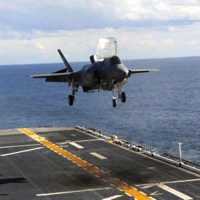The South Korean Ministry of Defense recently made the official announcement that it will purchase the F-35 fighter jet as part of an ambitious plan to modernize the country’s air defenses. Japan also plans to purchase the F-35, meaning that the two countries most central to the Obama administration’s Asia rebalance will be using the same platform.
This is good news for a fighter that has become the most expensive defense acquisition program in history. Although the U.S. Air Force has consistently maintained the importance of the F-35—and continues to robustly fund it under the recent fiscal year 2015 budget request—some in Congress have reacted with dismay to reports of cost growth as well as technical challenges associated with the fighter’s software and other systems.
In written testimony submitted last week to the House Appropriations Committee, Air Force Secretary Deborah Lee James and Air Force Chief of Staff Gen. Mark Welsh called the F-35 one of the Air Force’s “top three” acquisition priorities, along with the KC-46A aerial tanker and the next-generation strategic bomber. They called the F-35 “essential to any future conflict with a high-end adversary.”

